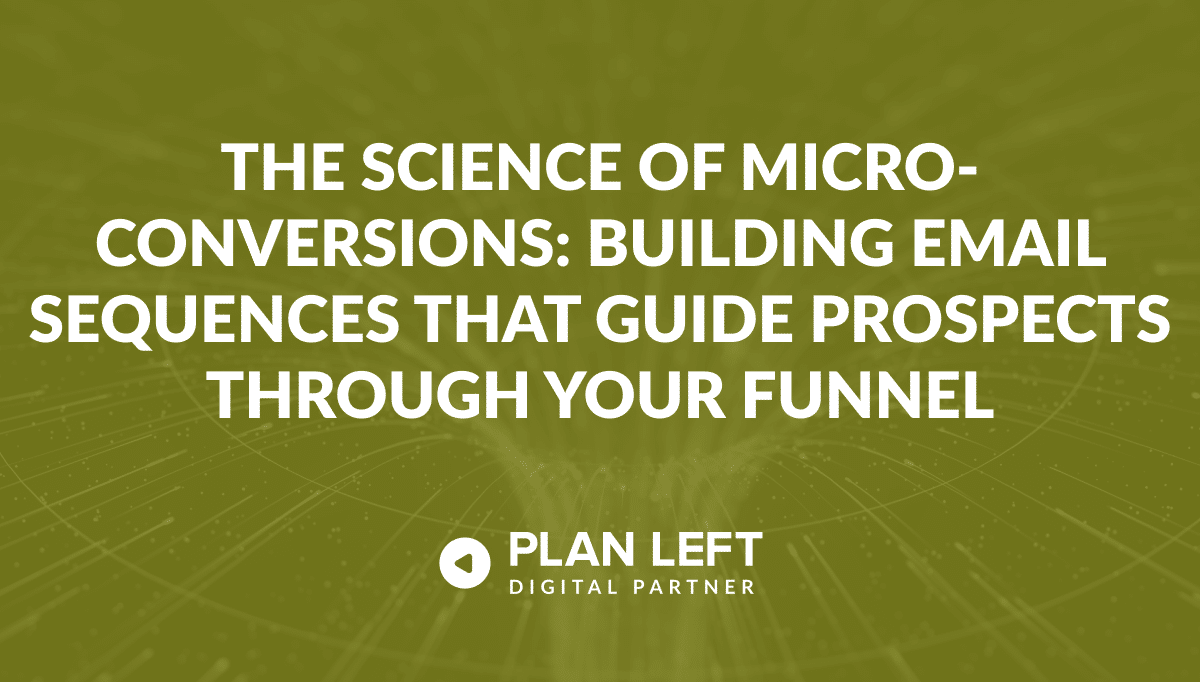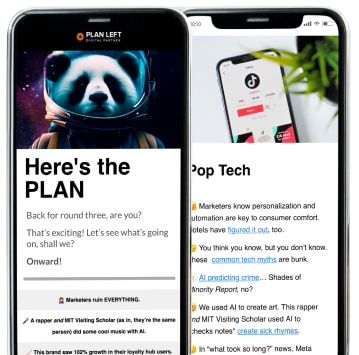
As AI Overviews decrease, the urgency around generative engine optimization builds. Plus, Google is keeping cookies, answers whether the order of header types matters for rank, and how to keep the value of your links on your website. SEO news with pro tips and more in this week’s Coffee & SEO.
Google AI Overview Results Decrease
BrightEdge released an analysis of AI overviews (AIO), which comes with insights for optimizing content. If you are a frequent reader of Plan Left blogs, you may remember What is GEO?, where we talked about how to optimize content for generative engine optimization (GEO). That was back in January, and here we are in July, reaffirming those callouts like the reliance on authoritative sources and citations from reputable websites like cdc.gov over user-generated content (UGC) like Quora and Reddit.
Overall, BrightEdge reported a decrease in AIO results across the board but largely noticed in specific industries like education (13%), eCommerce (17%), and entertainment (from 14% to 0%). This could be attributed to the decline in brand-specific searches (15%), general product categories (14%), and comparison searches (20%).
Where to Focus Efforts
Familiarize yourself with GEO if you are not already. By having an awareness of GEO, you are able to strategize better content efforts that optimize for both search and generative engines. Here are a few pro tips to get you started:
- Bullet Points – If you are not listing the steps of a process or the order of something, use bullet points. This format is a quick and easy reference for users and crawlers alike.
- Cite Sources – Choose trustworthy, authoritative sources over user-generated content without proof or a source confirming their statements.
- Answer User Questions – Frequently asked questions (FAQ) are popular for a reason. Use questions in search (People Also Ask) and keyword research within your content.
- Quality Content – User-focused content that offers relevant statistics, credible quotes, authoritative sources, and easy-to-understand content aligns with Google’s best practices but GEO as well. Focus on high-quality content for your target buyer.
Google Office Hours Answers Question About Header Order
According to Google, the sequence of your headers within your content does not matter to how content is crawled or ranked. Headers (H1, H2, H3, and so on until you reach H6) are essential in identifying the new sections of your content and help search crawlers determine the centerpiece annotation of your content or your main topic.
Why Headers in Sequential Order Matter to User
Screen readers use headers to understand the structure of content on a web page and also for navigation through the content. When headers are in sequential order (e.g., H1, H2, H3), there is a clear outline of the page content, which enables users to jump between sections quickly using keyboard navigation, for example.
Headers and User Experience Impact
A consistent and logical header sequence helps your overall user experience for both screen readers and non-screen readers. Taking the user from an H2 to an H4 to an H3 to an H6 confuses the layout of the content on the web page. It diminishes the value of the content you are providing to the reader, interrupting the flow of information. Disorganized headers can lead to a frustrating experience, increasing bounce rate.
Google Recommended Tips for Header Best Practices
When used strategically, headers can boost your SEO efforts and help your content be screen reader friendly. Here are some best practices to consider:
Use Sentence Case for Clarity
- Opt for sentence case in headers to help readability
- Example – “The art of baking sourdough bread” instead of “The Art of Baking Sourdough Bread”
Maintain a Logical Hierarchy
- Structure your content using appropriate heading levels (H1, H2, H3, etc.). Avoid skipping levels to maintain a clear content flow.
- Example hierarchy –
- H1: Mastering the Perfect Cup of Coffee
- H2: Choosing the Right Beans
- H3: Understanding Coffee Roasts
- H3: The Impact of Origin on Flavor
- H2: Brewing Techniques for Different Methods
- H2: Choosing the Right Beans
- H1: Mastering the Perfect Cup of Coffee
Keep It Concise and Descriptive
- Craft headers that accurately represent the content that follows. Aim for brevity while maintaining clarity.
- Example – “5 Essential Yoga Poses for Beginners” instead of “A Comprehensive Guide to the Most Important Yoga Poses That Novice Practitioners Should Learn and Master for Their Initial Practice Sessions.”
Avoid Unnecessary Punctuation
- Use punctuation sparingly in headers. Rephrase complex headers to eliminate the need for excessive punctuation.
- Example – “Mastering Time Management Skills” instead of “Time Management: How Can You Improve Your Skills?”
Incorporate Keywords Naturally
- Include relevant keywords and common questions or answers in your headers to improve SEO. Keywords should fit organically within the header, don’t force it or compromise readability.
- Example – “Budget-Friendly Home Decor Ideas” instead of “Cheap Decorating Home Budget DIY Ideas”
Source: Google Developer Documentation Style Guide
Google is Keeping Cookies
Google has changed its plans for third-party cookies (see previous cookie update here). Now, Google will continue to phase out third-party cookies on Chrome until they are phased out entirely by the first part of 2025. While third-party cookies are being phased out in Chrome, cookies as a technology are not disappearing entirely. The focus is shifting towards more privacy-centric approaches and first-party data strategies.
What Does This Mean for Website Owners and Marketers?
We need to prepare by adapting data collection and advertising strategies. First-party cookies will continue on, and to help support the transition, Google has introduced several tools as alternatives to third-party cookies:
- Federated Credential Management (FedCM) for federated identity services.
- Private State Tokens for anti-fraud and anti-spam measures.
- Topics API for interest-based advertising.
- Protected Audience for remarketing and custom audiences.
- Attribution Reporting for measuring ad impressions and conversions.
Watercooler Highlights
If you don’t want to lose the value of your web page links you may want to reconsider what you are indexing and not indexing on your website. And are you using your international website or website with multiple languages to its full potential? We have your tips and Google insights below.
Improve Rank With Country Code Domains and Language Targeting
You may remember when we reported on how Google manages multilingual websites earlier this year, specifically matching the language of a website to the language used by the user’s query and how that can have a greater impact on website rank than the domain itself. Google has now also confirmed that country code top-level domains (ccTLDs) receive a ranking boost when users search within the countries aligning with those ccTLDs.
For example, if a user is in the United Kingdom, results with .uk domains will be at the top of the search results before other countries are provided. This happens for a few different reasons:
- Local Domain Advantage – ccTLDs generally perform better in local searches because Google promotes content that is local to the user. For example, a .kr domain is likely to rank higher in Korea compared to a .com domain.
- Trust and Relevance – Users are more likely to trust and click on domains that match their country, which can improve click-through rates (CTR) and overall user engagement.
- Language Targeting – While ccTLDs offer a ranking boost, targeting the user’s language remains a critical factor. A site that matches the query language can outperform others, regardless of the domain extension.
Maintain Internal Link Value Simply By Making Them Crawlable
Per Google, blocking the crawling or indexing on an internal URL effectively cancels the linking power of any links on that page. This means that if a page is not available to users because it is blocked from indexing, any internal links on that page become irrelevant since users (and search engine crawlers) cannot access them. To keep linking power flowing on your website, it’s important that valuable pages are linked from indexable and relevant pages within your website (link tree). This approach helps preserve the value of your links and boosts your site’s overall searchability.
When to Use Noindex
Use noindex tags wisely. Apply them to pages you don’t want to appear in search results, but be cautious if these pages contain valuable links. It is important to regularly audit your site and evaluate any pages that are blocked from indexing and assess their impact on your linking strategy. Maintaining a clear link structure and optimizing internal linking affirms that your important pages remain accessible in Google’s search rankings.
Explore Latest Posts
Struggling with email marketing that generates opens and clicks but fails to deliver actual business results? The gap between engagement ... read more
July 17, 2025
Language should never be a barrier to digital access. Yet for millions of users worldwide, multilingual websites often become labyrinths ... read more
July 16, 2025
Accessibility has evolved from a nice-to-have feature into a fundamental business requirement. Organizations that treat accessibility as an afterthought often ... read more
July 14, 2025
Essential Strategies for Entrepreneurs
Get Actionable Business Insights & Marketing Tips
Our newsletter delivers real-world strategies from entrepreneurs who’ve been exactly where you are.
Sign up now for:
- Actionable growth strategies that work
- Insider tactics for attracting top talent
- Real-world case studies from successful founders
- Emerging tech trends that drive innovation
- Pragmatic marketing approaches for visionary leaders





